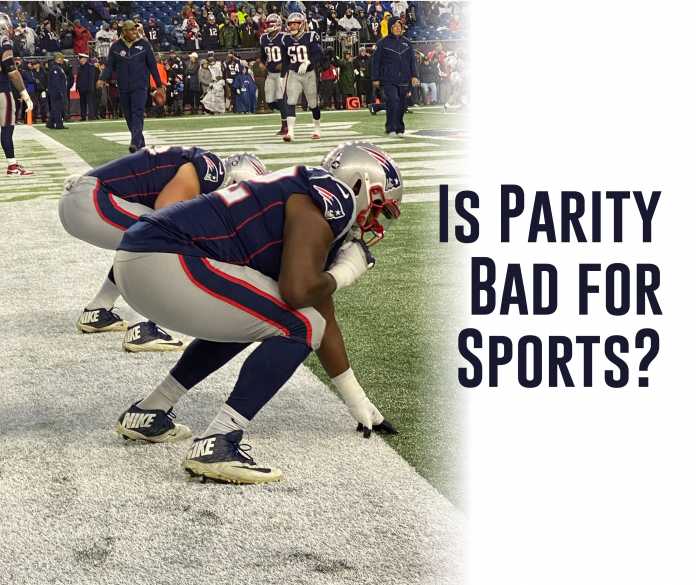Is Parity Bad for Sports?
We’ve debated it for years: Is a single team dominating sports bad for the league? Well, numbers would say no. Here’s why.
At the beginning of every season, every athlete, every coach, every fan lays on their bed imagining they could win a championship. That thirst for glory is what makes sports as great as they are.
We really can’t help ourselves sometimes as fans. You can have the worst roster in the league, and you’d still try and figure out a way to talk yourself into your team winning it all.
“If only this mediocre pitcher can go 10-5 next year, we could win a World Series!”
I can’t tell you how many times I heard that Jake Fromm and Feleipe Franks just had to be “good enough” for Florida and Georgia to compete for a national championship. Even as a Patriots fan last season – we’re always competing for a championship – I ignored our offense’s inability to get anything going in the red zone and just assumed we’d at least make the AFC championship.
But does every team have a legitimate shot? That has been the talk for nearly a decade now, as it appears only five or six teams can win a championship each season.
In the era that brought us the rivalries of the Warriors and Cavaliers in the NBA, Alabama and Clemson in the NCAA, and the New England Patriots against everybody else in the NFL, we’ve lost parity in almost all American sports. Why has that happened? And is it actually a bad thing?
Player Empowerment Era
The simple answer to many of these questions is that there’s been an unprecedented change in the athletes’ mindset of playing for the best teams. In the NBA, the idea of “super teams” started with the 2008 Boston Celtics and was followed by the 2012 Miami Heat and the 2017 Golden State Warriors. It’s been a cause for some controversy in the league, as players such as LeBron James and Kevin Durant have left their teams to join other teams with some of the other best players in the league.
But the idea of the super team started well before the infamous LeBron James decision to take his talents to South Beach. The MLB was the biggest proponent of this in America, with the birth of free agency and no salary cap allowing the New York Yankees and their deep financial pockets to court every free agent they wanted. European soccer has been that way for generations, as teams such as FC Barcelona and Real Madrid constantly buy out the top stars of smaller teams. It’s a natural progression in Europe as you grow your talents with the smaller teams and work your way to a team like Barcelona, which has one of the biggest fan bases in the world.
It has also been happening in college sports for years before the NBA. With recruiting comes an unfair advantage, as teams with more money can simply recruit more around the country. It’s simple math in that regard. Then as recruiting has become a more national competition, players are more inclined to play for the best of the best. If a kid had a choice between Alabama or their local university, they’re picking Alabama almost every time. In basketball, which teams are typically winning a championship? It’s always Duke, North Carolina, Kansas, and Kentucky. They have the recruiting and, therefore, the competitive advantage.
Even at the high school level, the rise of prep academies has given more power to the players in terms of choosing what is best for their futures. Teams like IMG Academy and Montverde Academy pluck the top end talent and in return offer these kids the most exposure to the top schools for their sports. Granting athletes the power of choice from youth sports to professional leagues has changed the landscape to where the rich get richer.
Is It a Bad Thing?
The next question that follows is always: Is it bad for the sport? Is it bad that Connecticut women’s basketball is always the favorite? Same goes for Duke, Alabama, and the Warriors. The simple answer is no.
If you simply look at TV ratings, the numbers back up that the greatest teams of all time also drive the highest viewership. We can go through it sport by sport.
In the NBA, the most viewed finals of the last 30 years involved Michael Jordan and Golden State with Kevin Durant and Stephen Curry. These are both regarded as two of the greatest dynasties in the history of the sport that dominated in a way nobody thought possible.
In the NFL, if you look at the highest rated Super Bowls of all time, four of the top six involve the New England Patriots, the greatest dynasty in the history of football. The other two games had Peyton Manning, winner of five MVP awards and regarded as one of the best quarterbacks in the history of the game. Fans gravitate toward dominance, and the Patriots and Manning had that in abundance. The ratings are also dominated by a considerable margin. The highest rated Super Bowl is the Patriots versus the Seahawks at over 115 million viewers. Last year’s Super Bowl? Over 104 million.
The same is true for college basketball, college football, and women’s college basketball. The highest viewed games involved Duke, Alabama and Ohio State for football, and Connecticut, respectively.
Greatness is something we all strive for, so everyone wants to see the best of the best. The ratings back that up. The other variable is the idea of getting to see the best lose. Everyone wants the team at the top to fall, so people will watch games just to see a team like Alabama lose. While it may seem unfair, the cost for parity is greatness.
Written by: Kyle Grondin



